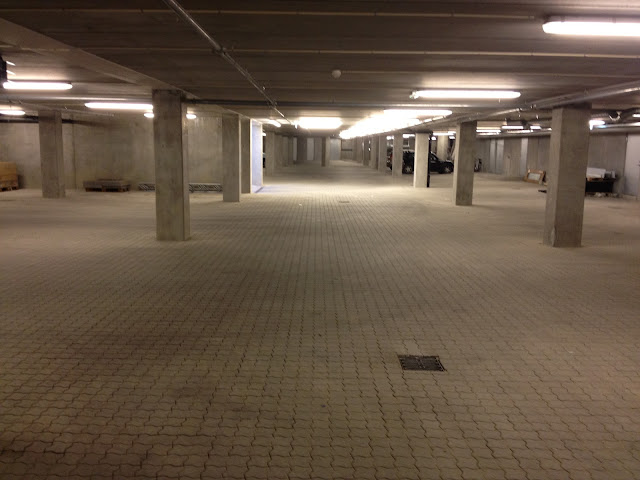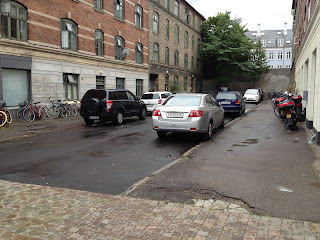
Parking The Bull - and Ignoring it Completely
 |
| Do we want to live on a parking lot? Picture: Lars Barfred |
The increasing number of parking lots and cars and, in the Danish perspective, even more frequent storms with wild amounts of precipitation - like we've seen the past few years - may well ensure our housing in cities becomes more integrated with our sewage system.
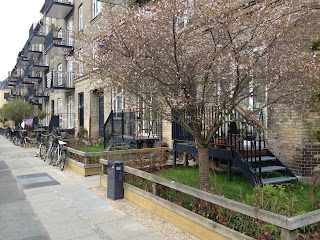 |
| The previous street could easily get the same gentle welcome style, in both sides of the street. The price: less pervasive parking, but still curbside (no 45 degree parking).
Picture: Lars Barfred |
Much of this is related to Copenhagen but, in my experience, it's the same dynamics and issue in most larger cities.
Although there are exceptions. Singapore, for example, has had a cap on the total number of cars in the country for decades. Even Boston, of all places, capped the total number of parking spaces in the inner city in 1978 in order to combat congestion. Seattle allowed developers to manage their need for on-site parking on their own. San Francisco has started implementing market pricing on curbside parking spots. These are great examples, but they are, unfortunately, rather rare.
We tend to think of cars primarily as a vehicle for driving when it is, in reality, not at all that. It is a parked vehicle for about 22 hours a day. According to a Danish newspaper, Politiken, it may be parked much more than that since almost half of Copenhagen car owners use their car once a week or less, on average.
Why is parking important? First of all, abundant free parking at the workplace increases the number of car commuters - by around 100%, accordingly to the Danish Technical University. In Denmark, perks acquired at your job are taxed - anything above 100 DKK ($170 USD). The only exception is free parking. Which is bizarre when you consider the value of a parking spot. The City of Copenhagen's Finance Department has recently calculated that a parking spot in the city centre may be worth as much as a whopping 1 million DKK ($170,000 USD). In California, the state has introduced a reversed model in order to combat rush hour congestion. If a company supplies free parking to employees, the company must pay an allowance of equal worth to all employees who do not commute by car. Secondly, all this parking takes up a great deal of space in our cities. A parking space is about 12 m2. But if you include the necessary access area you need to calculate about 25 m2 if you're planning a parking lot, underground facility or facility with random entry and exit - and without valet service.In Copenhagen 36.5% of all the asphalt is used for public parking. If you include private parking, 50% of the asphalt in the city is for driving and 50% is for parking.
It gets worse. The common assumption is that one car fits into one parking spot. It is never that low, however. In the US, it can be between 2 and 8 parking spots per car. In Copenhagen, my conservative analysis suggests that there are between 3 and 3.6 spots per car, both public and private.
The reason that one parking space is never enough is a combination of differences in need, according to character of the destination, job, home, shopping, entertainment etc.. In addition, a high share are reserved for one car only - your driveway is not used by anyone else while you are at work and, chances are, nobody uses your parking space at work, when you're not there. There may be no need or your company has reserved it just for you and you alone. Parking spots outside a sports stadium will usually be empty 99% of the year... and so on.
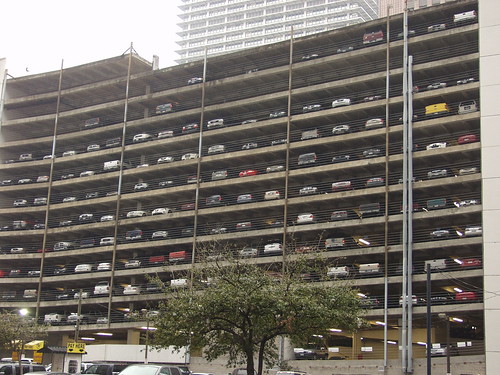 |
| Living the nightmare -Parking facility downtown Houston. Picture: Tilemahos Efthim |
One of the unfortunate side effects is that nobody can make money on parking, so no private entity is willing to invest in parking unless they are forced to by the city. If a rent-controlled, socio-economic residential complex wanted to let the residents who own cars pay the cost of the parking spaces that the city forced them to build, they would just opt to park in the street, where it is free. The result is that all low-income families, car or not, have to pay for the parking spaces.
Eash parking spot in an underground facility costs around $64,000 USD - which is about equal to 10% of the property value. Housing expenses in the capital could be up to 10% lower if the city allowed car-free apartments. It doesn't, however.
It's not only our housing expenses that are affected. When retail is forced to pay a higher rent due to a high number of parking spaces - one for every 100m2 of retail space - the consumer goods they sell will increase in price - retailers will seek to earn a premium after all costs are covered.
When museums are forced to use money on parking spaces, they have less for exhibitions. When schools are forced to provide parking spaces for students, they have less for education and facilities. Why are universities forced to provide parking, but not dormitories? No Copenhagen universities build or offer student housing.
When you don't pay for a service you tend to demand more of it - as much as you can possibly consume - since there is no trade-off necessary for you as an individual.
I can guarantee you that if Copenhageners had to pay the cost price of a parking spot, 35-50% would opt for a car-share service, car rentals, taxi or no car at all. I will come back to these percentages with a case example.
 |
| Ultimately we need to kinds of curbside parking; Car share and unloading zones. Picture: griin.de |
For shops, low parking prices are a disaster because there is no motivation to park, shop and leave again in a timely manner, this means a lower customer flow. If parking was more expensive, many may choose to use public transit or bicycles for purchases that don't require a car or when travelling in a group. In Copenhagen, one car is, on average, only occupied by 1.1 - 1.3 people.
If parking was expensive outside the shop, the store employees would likely choose to park farther away from the store, instead of occupying spots which should be used by customers, which again means less business, and fewer jobs for the store employees. A recent report compared the economic growth of the ten most car-friendly cities in the US with the ten worst. The economic growth of the car-friendly cities was significantly and consistently below that of the least car-friendly cities.Lack of free parking has been shown to increase traffic volume as much as 30%. If parking pricing is matched to demand, there will always be available parking on the same block as the destination shop or restaurant - creating less traffic on the streets and more traffic and revenue in the shops. This is exactly how the pricing of real estate works and how the pricing of retail space works. This is how the market works. It's a simple principle. For some peculiar reason even neo-liberals do not believe in the market when it's related to car parking.
Suddenly, parking and car ownership has become a social issue and the high cost of parking is punishing the poor. What is unfair and punishing is if the poor are forced to drive by car because all the parking spaces take up the most valuable space in the city - instead of being allocated to affordable, high class, reliable and frequent public transit and bike infrastructure.
My Back Yard!
In my neigbourhood of Copenhagen, Skt. Kjelds Plads, public parking is free. There are 4700 public parking in curbside spots. This is in an area of 1500 km x 750 meters. 10.5% of the entire surface area is allocated to parking. That is a lot by any standard. It shows, too. Most streets are parking lots, which doesn't invite life during the day and evening. No outdoor café tables, no playing children and virtually no shops except tanning shops and discount supermarkets. The City has meticulously registered parking patterns. In the evening, the pressure peaks, which means residents own cars. The neighbourhood is "known" to have a much higher parking demand, than it can satisfy.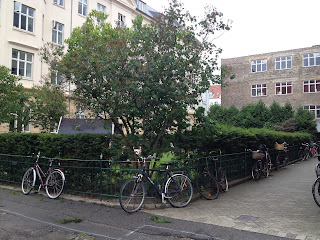 |
| 2-3 blocks away, somebody actually realized this idea, with a little creativity, it could have been even more
welcoming and playful ;-) |
Maybe the remaining car owners would even start to enjoy the longer walk from the car to the front door?

